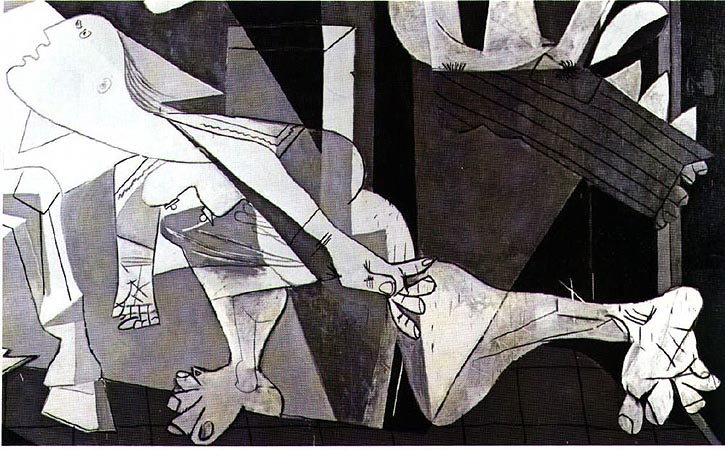Guernica is a painting central to understanding the motivations behind both characters in "a Picasso" I have become slightly obsessed with this painting, and through my digging have discovered quite a number of amazing facts (mostly from Wikipedia, but again, extremely condensed to the pertinent info and with a million images added to enhance your experience). For example, I had no idea of the sheer enormity of the painting:
Guernica is grey, black and white, 11 ft tall and 25.6 ft wide, a mural-size canvas painted in oil. Picasso's purpose in painting it was to bring the world's attention to the bombing of the Basque town of Guernica by German bombers, who were supporting Franco during the Spanish Civil War. Picasso completed the painting by mid-June 1937.
Deaths in Guernica:
In 1937, von Richthofen wrote that most of Guernica's inhabiatants were away on holiday resulting in few deaths. However, other accounts state that the town's inhabitants were in fact congregated in the center of town, as it was market day, and when the bombardment commenced, were unable to escape the inferno because the roads leading out of the center of the town were full of debris and the bridges leading out of town had been destroyed.
Guernica shows suffering people, animals, and buildings wrenched by violence and chaos.
Painting details:
I condensed all the symbolic awesomeness to a few key items:
- The overall scene is within a room where, at an open end on the left, a wide-eyed bull stands over a woman grieving over a dead child in her arms.
- The centre is occupied by a horse falling in agony as it had just been run through by a spear or javelin. The large gaping wound in the horse's side is a major focus of the painting.
- Two "hidden" images formed by the horse appear in Guernica:
- A human skull overlays the horse's body.
- A bull appears to gore the horse from underneath. The bull's head is formed mainly by the horse's entire front leg which has the knee on the ground. The leg's knee cap forms the head's nose. A horn appears within the horse's breast.
- Under the horse is a dead, apparently dismembered soldier; his hand on a severed arm still grasps a shattered sword from which a flower grows.
- On the open palm of the dead soldier is a stigma, a symbol of martyrdom.
- A light bulb blazes in the shape of an evil eye over the suffering horse's head (the bare bulb of the torturer's cell.) This is related to the Spanish word for lightbulb; "bombilla", which makes an allusion to "bomb".
- To the upper right of the horse, a frightened female figure, who seems to be witnessing the scenes before her, appears to have floated into the room through a window. Her arm, also floating in, carries a flame-lit lamp. The lamp is positioned very close to the bulb, and is a symbol of hope, clashing with the lightbulb.
- Daggers that suggest screaming replace the tongues of the bull, grieving woman, and horse.
- On the far right, a figure with arms raised in terror is entrapped by fire from above and below.
Symbolism and interpretations
The following list of interpretations reflects the general consensus of historians:
- The shape and posture of the bodies express protest.
- Picasso uses black, white, and grey paint to set a somber mood and express pain and chaos.
- Flaming buildings and crumbling walls not only express the destruction of Guernica, but reflect the destructive power of civil war.
- The newspaper print used in the painting reflects how Picasso learned of the massacre.
- The broken sword near the bottom of the painting symbolizes the defeat of the people at the hand of their tormentors.
Picasso's comments on the work
When pressed to explain symbols in Guernica, Picasso said,
However, Picasso said as he worked on the mural:...this bull is a bull and this horse is a horse... If you give a meaning to certain things in my paintings it may be very true, but it is not my idea to give this meaning. What ideas and conclusions you have got I obtained too, but instinctively, unconsciously. I make the painting for the painting. I paint the objects for what they are.[3]
"The Spanish struggle is the fight of reaction against the people, against freedom. My whole life as an artist has been nothing more than a continuous struggle against reaction and the death of art. How could anybody think for a moment that I could be in agreement with reaction and death? ... In the panel on which I am working, which I shall call Guernica, and in all my recent works of art, I clearly express my abhorrence of the military caste which has sunk Spain in an ocean of pain and death."
But far from being a mere political painting, Guernica should be seen as Picasso’s comment on what art can actually contribute towards the self-assertion that liberates every human being and protects the individual against overwhelming forces such as political crime, war, and death.[7]
And then there's this:
While living in Nazi-occupied Paris during World War II, Picasso suffered harassment from the Gestapo. One officer allegedly asked him, upon seeing a photo of Guernica in his apartment, "Did you do that?" Picasso responded, "No, you did."




Awesome blog Chelsea! wow, such an interpretation of art in a painting. Picasso would have been pleased we are thinking about his art so.
ReplyDelete